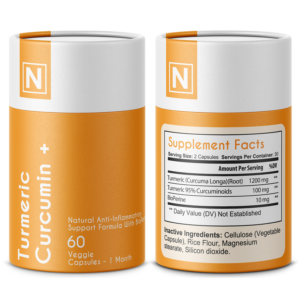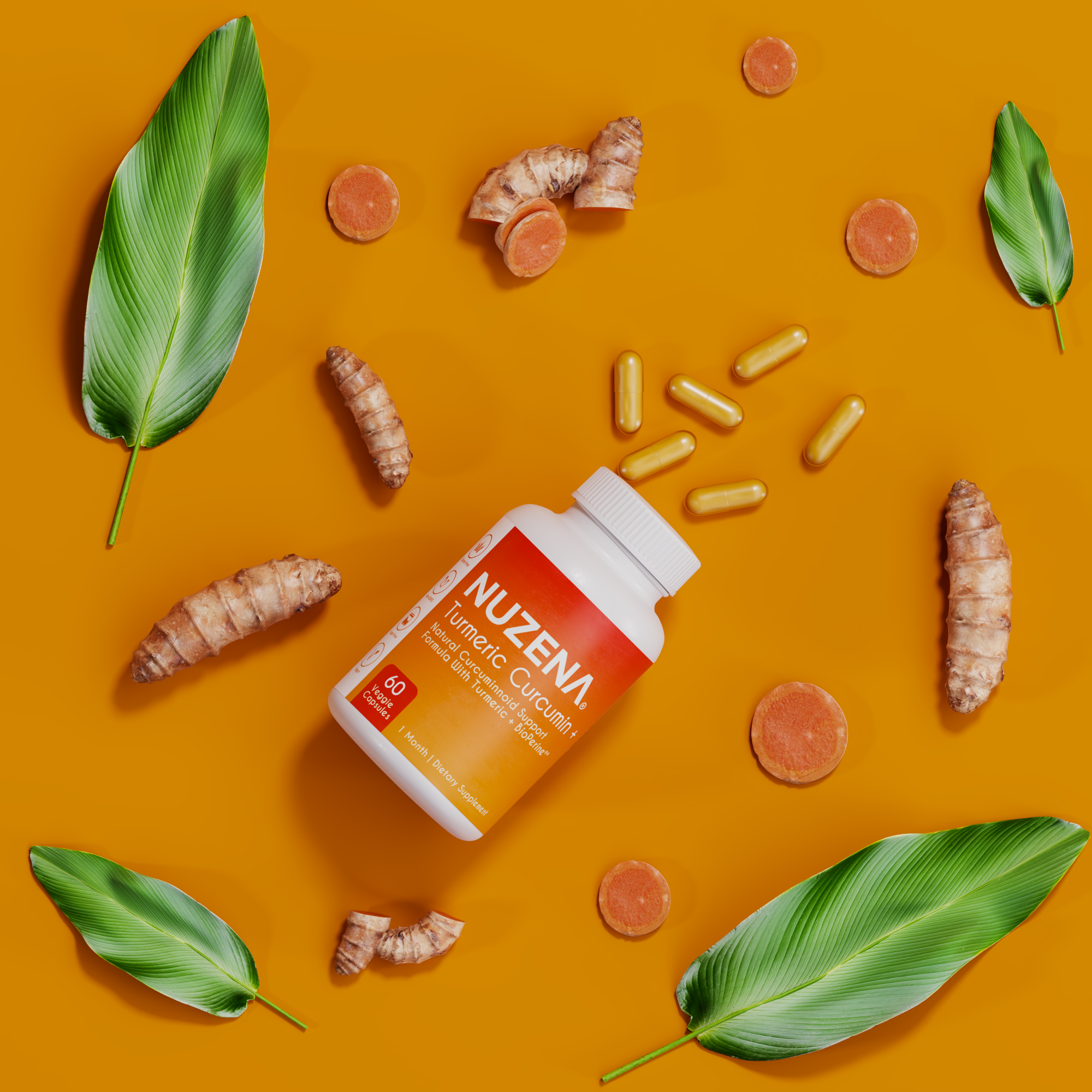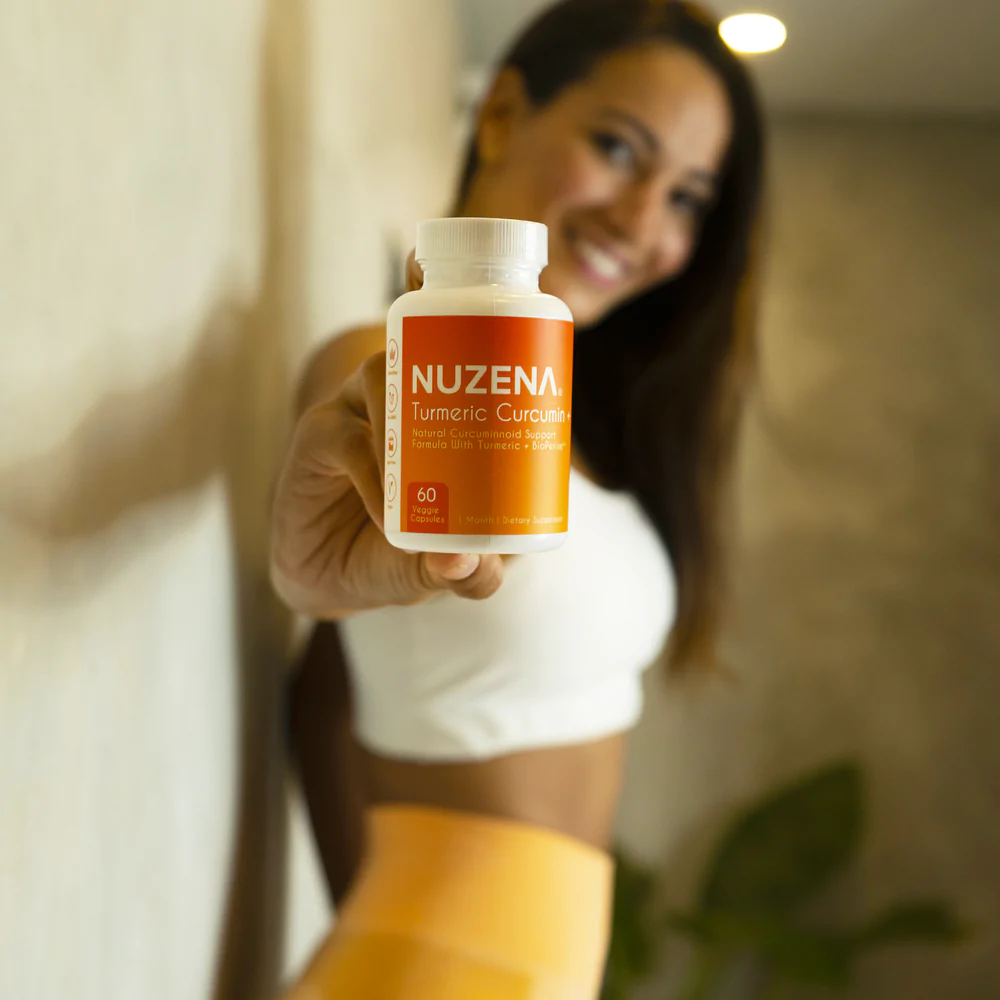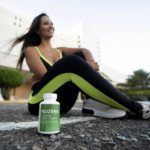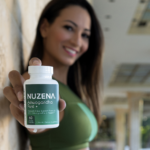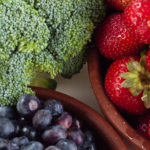
Written by Anita Tee, MSc Personalized Nutrition, BSc Genetics & Microbiology – Reviewed by Sam Thomas, BSc Biology (Hons.)
Last updated: November 7, 2019
What is Turmeric?
It’s not called the Golden Spice for nothing. This natural plant food is both golden in color, and can be considered as one of the most valuable commodities; particularly when it comes to human health, that is.
While turmeric is well known for its role as a spice that has been used to flavor and color food dating back 400 years, turmeric is actually a flowering, herbaceous plant called Curcuma longa, which closely resembles the ginger family, both of which the roots are used in cooking. Offering over 45 different species in this area alone, Curcuma is native to the Indian subcontinent, which subsequently produces nearly all of the turmeric in the world. This population has also been found to consume as much as 80% of that which it produces, where the rhizomes, or roots of the plant, are collected for consumption either in a fresh, boiled preparation or in dried form, which is typically the spice. Worldwide, as many as 133 species of the plant have been identified, however, that which originates in India, and in particular, in a city in the South Indian state of Tamil Nadu, called Erode – the largest producer – is considered to be the best quality in the world.
Interestingly, only a specific species that is native to South India is designated Curcuma longa, and other species of the plant that has been cultivated in other parts of the world still require validation and categorization. These species are often simply utilized and sold as turmeric(1).
13 Proven Health Benefits of Turmeric
1 Turmeric helps to reduce inflammation
Reaching for a painkiller like ibuprofen or aspirin? Why not reach for turmeric instead.
Research has shown turmeric and its extracts to inhibit the production of various chemical messengers in the body that are associated with inflammation, such as TNF-a and prostaglandin E2. In one study, in particular, researchers found that turmeric oils were most effective in the inhibition of PGE2, even when compared to curcuminoids(3).
Now, inflammation has a very special role in the body. It offers a tremendous amount of protection from otherwise deadly infections, and it helps the body to heal when there is any form of tissue damage. Inflammation, however, when not moderated, and essentially, when it doesn’t ‘switch off’ when it has done its job, can lead to serious medical conditions. It is for this reason that inflammation is often referred to as the root cause of all disease.
Fortunately, turmeric is well-studied for its role in inflammatory conditions because of the way it acts on those inflammatory pathways mentioned above(4). In fact, it has been suggested that turmeric and its curcumin compound are just as effective – or even more so – than pharmaceutical painkillers; without the same side effects(5).
Conditions that have been found to be mediated by turmeric are:
Summary: Turmeric may be effective in helping to reduce inflammation. Some studies suggest the curcuminoids found in Turmeric may be as effective as some pain killers in treating inflammation.
2 Turmeric helps to regulate blood sugar level
Turmeric may help to treat and prevent diabetes. Diabetes is a condition in which the body is unable to regulate the use of sugar, or glucose, as it is called when in the blood.
In type 1 diabetics, this is as a result of insufficient production of the hormone insulin, which promotes the movement of glucose into the cells. In type 2 diabetics, the disorder develops when the cells no longer respond to the messages from insulin, and, in both cases, blood glucose levels can become dangerously high. In studies in animals, it has been shown that the turmeric extract curcumin, may help in a variety of pathways relating to diabetes.
Along with blood sugar balance and improved insulin control, this compound has been shown to exert its effects through anti-inflammatory and antioxidant properties. The significance of this is that co-existing conditions in diabetics that arise as a result of blood sugar imbalances, put them at risk of nerve damage, high cholesterol, heart disease and metabolic syndrome. By targeting inflammation and oxidation, turmeric’s cucrcumin compound may improve these outcomes for this group of the population, reducing the risk of limb amputations, kidney disease and the worsening of health through related conditions(9,10,11,12).
Summary: Several clinical studies of Turmeric indicate that it may be effective in rregulating blood usgar levels.
3 Turmeric helps with numerous digestive disorders
Ashwagandha, as we have mentioned above, helps to reduce cortisol levels that are secreted from the adrenal gland.
Multiple benefits have been reported on the digestive system with the use of turmeric. For example, it has been used for reducing flatulence, bloating, pain and cramping, and even for loss of appetite and reducing the feeling of post-meal fullness. In organ systems of the digestive system, there is evidence to support turmeric in promoting:
- Liver health. One of the most essential detoxification organs in the body is the liver. Almost every compound that enters the body that is transported in the bloodstream is processed by the liver. The liver performs two important processes involved in detoxification, which requires a significant amount of nutrients to be available. Should there be reduced availability of these nutrients for any reason, the liver is at risk of being damaged itself, due to the toxins that it has to process. Fortunately, there is a major antioxidant molecule the body makes to protect the liver, and it’s called glutathione. Glutathione is, however, readily used up when there is an increase in inflammation and oxidation, and lower availability of glutathione can leave the liver at risk of damage. Turmeric has been found to provide assistance to the liver through free radical scavenging activities and modulating the levels of glutathione that is available for use(13).
- Gallbladder function. Turmeric is a cholagogue, which is a compound that acts by stimulating bile production in the liver and encouraging excretion of bile via the gallbladder. Bile is an important part of the body’s mechanisms to digest fats(14).
- IBD. Cramping and pain are often associated with inflammatory bowel conditions, however, with turmeric, one may find natural relief due to its antispasmodic and antiflatulent activity(15).
- Stomach. In one study, it was shown to have the most effect against H. pylori infections in the stomach(16).
Summary: Studies of turmeric indicate that it can be helpful in supporting numerous digestive disorders including consipation, gut inflammation, and irritiable bowel syndrome.
4 Turmeric is an antimicrobial
When it is considered that the human body carries around the approximate weight of 1.5kg of microbes internally and externally, it provides insight into the importance of their function. Microbes can be described as organisms that fall into the bacterial, viral, parasitic and yeast/fungal classes of species, and they all have their own role to play in human health.
Infections and drastic changes in the microbiome composition, are a serious risk to health and wellbeing across the human population, with imbalances in the diversity of the species typical of the human host, receiving increased interest in areas of research in health and disease.
Microbial imbalances are not always due to infections like E. coli, a serious diarrhea-causing bacteria, for example. Specific microbial colonies that are typically found in the human body may flourish in some environments over others, and result in the development of particular symptoms of ill health.
Histamine, for example, a typically beneficial compound produced by various species of bacteria in the gut, may have adverse effects when released in quantities higher than those required for normal physiological processes. Turmeric, with its antimicrobial properties, has been shown to effectively reduce histamine release by various bacteria in the gut, in addition to inhibiting the enzyme that the body produces that converts the amino acid histidine to histamine(17).
There are numerous other ways in which turmeric is purported to have antimicrobial effects, and these include conditions such as:
-
- Chronic anterior uveitis
- Conjunctivitis
- Smallpox
- Chicken pox
- UTIs
- Colds
- Turmeric paste is even used in wedding ceremonies in parts of India, Bangladesh, and Pakistan. Applied to the skin of the bride and groom, it is believed to keep harmful bacteria away from the body.
Summary: Studies of Turmeric indicate that it may be useful in helping to restore the health of microbiome. Turmeric may also be helpsful in keeping harmful bacteria away from the body.
5 Turmeric helps to support cognitive function
In decades past, the decline of mental health and cognitive ability were only a worry in the elderly. Today, many more people are being diagnosed with various cognitive disorders. Brain fog, poor concentration, memory lapses, depression and even some forms of dementia are appearing in far younger people. One of the reasons has been suggested as being due to brain, or neuro, inflammation.
There are numerous factors that influence neuroinflammation. Toxins in the environment, those that can be found in food, poor dietary choices, reduced levels of physical activity, trauma, chronic illness, poor gut bacterial composition, you name it, they all have a significant impact on the brain’s ability to function at an optimal level.
As has already been indicated, turmeric has potent anti-inflammatory properties, which is an essential mechanism whereby it exerts its beneficial effects on brain health. In addition, the antioxidant properties of turmeric play a role in reducing the risk of cognitive decline. Oxidation, which is a process in the body that produces unstable molecules, called free radicals, may lead to decreased cognitive health when they are not controlled. In a healthy individual, the availability of antioxidants helps to manage the level of free radicals, which mitigates their tissue destroying action. Where oxidation levels are higher, and too few antioxidants are available, free radicals cause more tissue damage and more inflammation, which, in the brain, leads to poorer function. In addition to dampening the inflammation that oxidation causes, turmeric provides antioxidant molecules to manage the free radical molecules, offering a double punch against these harmful processes.
Toxins have been found to have a huge impact on brain health and function. Heavy metals, in particular, such as lead, aluminum, cadmium, and mercury, which enter the body through the environment or the food a person eats, may bypass the protective layers of the brain and cause damage to the tissues, interfering with function. Turmeric has been shown to promote heavy metal detoxification, thereby reducing their effect on the brain and other body tissues.
When it comes to age-related cognitive decline, Alzheimer’s disease, which is the most common form of dementia, is a particularly scary possibility for so many. It is a condition whereby the brain is unable to effectively remove waste products, which interferes with its ability to manage a number of complex processes involved in protein metabolism. One of the hallmarks of Alzheimer’s diseases is the collection of unfolded proteins, which leads to the accumulation of protein tangles in the brain. It’s this disease process that is reflective of the symptoms associated with this particular type of dementia, such as confusion, poor planning and problem solving, memory loss and trouble with speaking. Turmeric has been recognized as having the ability to slow the rate of protein tangle accumulation, which may reduce the progression of symptoms associated with Alzhiemer’s disease(18,19,20).
Summary: Turmeric may act as natural anti inflammatory support to protect against neuroinflammation. Turmeric may optimize brain fucntion and help to improve memory recall.
6 Turmeric helps to lower the risk of heart disease
Through various mechanisms, it has been proposed that turmeric may play a role in alleviating the burden of the world’s deadliest killer: heart disease. It is the number one ranked fatal disease worldwide, and its precursor condition, high blood pressure, has been called the silent killer.
Turmeric, because of its anti-inflammatory and antioxidant effects, may reduce the damage to the endothelial tissue in blood vessels, which are often at high risk of damage due to increased inflammation. Inflammation affecting endothelial function and raising the risk of heart disease is common in those with inflammatory health disorders, as one ages, and even due to drastic changes in hormones, as is noted in postmenopausal women.
When compared to an exercise program to reduce heart disease risk, the turmeric extract curcumin was able to produce equal improvements in endothelial function(21,22).
Summary: Due to Turmerics antiinflammatory and antioxidant properties, it may be effective in helping to reduce the risk of heart disease.
7 Turmeric has been the subject of cancer research
There is evidence to suggest that turmeric may elicit anticancer activity through inhibition of cell proliferation as well as the induction of programmed cell death of dysfunction cells, both of which are associated with tumor development and growth.
In one study, apoptosis, which is the death of a cell, was shown to be induced in human leukemia cells when a compound, isolated from turmeric, was added(23).
Various studies have also reported the anticancer activity of turmeric in skin, breast, oral, and stomach cancer, with the mechanisms of action being proposed as those including inhibition of the development of mutant cells, the detoxification of cancer-causing compounds, decreasing the rapid division of cells and increasing cell death of dysfunctional cells(24).
Summary: Although there is still further research needed to be done, the anti-inflamamtory properties of turmeric have been researhed for their benefit in helping to prevent some cancers.
8 Turmeric has anti-ageing properties
One of the reasons the body ages is that general body processes reduce the capacity at which they can function the longer they are required to do so. Optimal cellular mechanisms may slow due to a number of internal and external factors. Slowing of these processes reduces the body’s ability to repair damaged tissue as quickly as it did in younger years, but what causes this? Oxidation.
Oxidation, and the subsequent development of free radicals once again comes into play, just like it does when it comes to cognitive decline. Too many free radicals and insufficient availability of antioxidant compounds lead to the timed decline in the body’s repair process.
Consider the skin. Free radical damage reduces the ability of skin cells to repair themselves, it affects the placement of the minerals, vitamins and other nutrients involved in maintaining the structure and rigidity of the skin, and it causes the skin to lose its barrier function. The consequence? Those symptoms commonly associated with ageing begin to appear. Looser, thinner skin, wrinkles, and age spots.
These processes take place on the inside of the body, too. They don’t necessarily involve the formation of wrinkles and loose skin, however, the function of the cells and organs becomes inefficient, resulting in the development of both internal and external signs of ageing.
Turmeric, and, in particular, curcumin, has the ability to neutralize these free radicals due to its potent antioxidant properties. Additionally, it has been found that curcumin is able to enhance the effects of the body’s own antioxidant manufacturing process, increasing the availability of these free radical fighting compounds overall(25,26,27).
Summary: Turmerics antioxidant properties may help reduce the effect of cellular oxidation in your skin. This may help to promote healthier and more hydrated skin.
9 Turmeric may support menstrual problems
Many women suffer difficult periods due to changes in their hormones and fluctuations during the month, as well as subsequent release of inflammatory chemicals in response. The changes a woman goes through as a result may bring about heavy bleeding, cramping, feelings of nausea, lethargy, and many other symptoms that can persist for days at a time.
Turmeric, classified as a warming herb, has been shown to be helpful in regulating and balancing these hormonal fluctuations, with potential to regulate menstrual flow and alleviate some of the symptoms associated with this time of the month(28,29).
Summary: Turmeric may help in balancing hormonal fluctuations during the menstration cycle.
10 Turmeric and its use as an antiseptic
In addition to its antimicrobial properties, turmeric can be used as an antiseptic.
Many South Asian countries use it as a treatment for cuts, burns, and bruises, in addition to it being an antibacterial agent. In Pakistan and Afghanistan, turmeric is used to cleanse wounds and stimulate their recovery due to its natural antiseptic, disinfectant, analgesic and anti-inflammatory properties(30,31).
Summary: Some studies show that Turmeric may also have use as a natural antiseptic, and disinfectant due to its anti-inflammatory properties.
11 Turmeric may provide respiratory support
From asthma to bronchial hyperactivity, chronic coughs and even allergic hay fever and common colds, turmeric may be just what is needed to provide relief for those symptoms that affect the respiratory system. In one study, children and adolescents with persistent asthma, who were given turmeric for 3 to 6 months, drastically improved in their symptoms and had better disease control overall(32,33).
Those practitioners who practice Unani medicine have also used turmeric to expel phlegm, or what they refer to as kapha.
Summary: Some research shows that turmeric may be helpful in supporting healthy respiratory function.
12 Turmeric helps to support skin conditions
Ance, alopecia, atopic dermatitis, psoriasis, pruritus and vitiligo are all chronic skin conditions that have been associated with inflammatory disorders. Turmeric, when taken both orally or applied to the skin in topical form, have been shown to provide therapeutic benefits for skin health.
Turmeric paste has also been touted as a hair removal remedy, used by women in some parts of India to address hair in superfluous placed. In addition, it is often a base of sunscreen and face cream due to its free radical fighting properties(34).
Summary: Turmeric may help to support a variety of skin conditions due to its powerful antioxidant and antibacterial effects.
13 Turmeric offers several nutritional benefits
Over and above the health benefits to seemingly every organ and tissue in the body, it should be remembered that turmeric can act as a food source for its overall nutrient composition. It contains fibre, minerals and vitamins that can add to those required daily by the body. Turmeric can be added to just about any meal to offer an earthy flavour as well as some colour. In more recent times, turmeric-containing beverages have also become popular; golden turmeric lattes, for example, are quite trendy in colder months – and for good reason! Just think about all the health benefits, all packed into one soothing drink(35).
Summary: Turmeric also provides several daily required nutrients for our diet. It is abundant in vitamins, minerals, and is a good source of fiber
Side Effects
1 Turmeric may not be safe to take while pregnant
While studies of Turmeric indicate that it is non-toxic and generally regarded as safe (GRAS) herbal ingredient, some physicians have noted that it should most likely not be consumed if pregnant (32).
This is possibly more of a precautionary measure than an explicit warning, based on the overwhelming evidence to suggest that Turmeric is safe to consume.
There is no clinical evidence to back up the statement that Turmeric is unsafe for pregnant women, however as with any treatment, whether it be natural, prescription or otherwise it is generally best to seek the advice of a doctor if you are unsure.
Summary: Overwhelming evidence suggests that Turmeric is safe to consume as it is non-toxic, and is on the GRAS list (generally regarded as safe), however, pregnant women should likely avoid consuming it without the supervision of a doctor.
2 Not all Turmeric products are organic
What are some times the case with natural and herbal remedies and supplements, in particular, is that the ingredients used in a formula may not be organic, tested for allergens, approved in an FDA registered facility, or even tested for its potency.
Ensure that when you are buying Turmeric products that they are organic, sustainably sourced, have been tested for allergens and that the dosages are actually what they say they are on the bottle. It comes down to trust, reputation, and reviews.
Summary: Buy Turmeric from a trusted source and ensure that it is pure, free from allergens, free from harmful chemicals, and that it is made inside an FDA registered facility.
3 Turmeric may act negatively with other medications
Turmeric and its active component curcumin is effective in its use as antural anti-inflammatory. It may not be suitable to take in conjunction with other medications, particular hormone-altering medications.
For more advice on what you can and cannot consume with Turmeric is it always best to consult your doctor if you are currently on medication.
Summary: Turmeric may act negatively with other medications so it is always best to consult your doctor, who knows your current prescription, and medical history.
Recommended Dosage
1Turmeric dosage
Based on the evidence that we’ve examined in the clinical studies above, the most consistent dosage of Turmeric administered ranges from 800mg-1200mg as a daily total.
The examples for the duration of which this is administered appear to be most consistently in the range of 60-90 days.
While there are most certainly outliers to the above ranges, in which some patients achieved the desired effect with less or more, over a shorter or longer period, these appear to be the most representative of the studies examined.
Summary: The recommended Turmeric dosage to see the noticeable physiological benefit is between 800mg-1200mg total daily, with the duration of consuming it ranging being 60-90 days.
Final Thoughts on Turmeric
1Turmeric summary
Turmeric has been used for centuries in food, however, there is a significant amount of history, the earliest of which has been collected from Sanskrit medical treatises, provides evidence for the use of it in ancient – Ayurvedic, Siddha, Unanu and traditional Chinese – medicine. The reason behind this lies in the compounds that make up the food.
In powdered form, per 100g, the nutritional value has been determined to be as follows: 70g carbohydrates, 8g protein, 10g total fat, 3g saturated fat, 3g sugars, 21g dietary fiber, 0 mg cholesterol, 0.2 g calcium, 0.26 g phosphorous, 10 mg sodium, 2500 mg potassium, 47.5 mg iron, 0.9 mg thiamine, 0.19 mg riboflavin, 4.8 mg niacin, and 50 mg ascorbic acid. It also comprises >9% water, and 5-7% curcuminoids(33). In terms of health properties, it’s this last ingredient, the curcuminoids, that are of the greatest interest in their health benefits.
While adding raw to you diet is great, it can at times be inconvenient or undesirable to do so. If this is the case then you may wish to take a turmeric curcumin supplement orally instead which can have equally as fantastic benefits.
References
- On the identity of turmeric: the typification of Curcuma longa L. (Zingiberaceae) JANA LEONG-ŠKORNIČKOVÁ, OTAKAR ŠÍDA, SIRIL WIJESUNDARA, KAROL MARHOLD. Botanical Journal of the Linnean Society, Volume 157, Issue 1, May 2008, Pages 37–46 https://onlinelibrary.wiley.com/doi/abs/10.1111/j.1095-8339.2008.00788.x
- J Med Chem. 2017 Mar 9;60(5):1620-1637. doi: 10.1021/acs.jmedchem.6b00975. Epub 2017 Jan 11. The Essential Medicinal Chemistry of Curcumin. Nelson KM1, Dahlin JL2, Bisson J3, Graham J3, Pauli GF3,4, Walters MA1. https://www.ncbi.nlm.nih.gov/pubmed/28074653
- Lantz R. C, Chen G. J, Solyom A. M, Jolad S. D, Timmermann B. N. The effect of turmeric extracts on inflammatory mediator production. Phytomedicine. 2005;12:445–52. https://www.ncbi.nlm.nih.gov/pubmed/16008121
- Safety and anti-inflammatory activity of curcumin: a component of tumeric (Curcuma longa).
- Chainani-Wu N. J Altern Complement Med. 2003 Feb;9(1):161-8. https://www.ncbi.nlm.nih.gov/pubmed/12676044
- Nonsteroidal anti-inflammatory agents differ in their ability to suppress NF-kappaB activation, inhibition of expression of cyclooxygenase-2 and cyclin D1, and abrogation of tumor cell proliferation. Takada Y1, Bhardwaj A, Potdar P, Aggarwal BB. Oncogene. 2004 Dec 9;23(57):9247-58. https://www.ncbi.nlm.nih.gov/pubmed/15489888
- A Randomized, Pilot Study to Assess the Efficacy and Safety of Curcumin in Patients with Active Rheumatoid Arthritis. Binu Chandran1 and Ajay Goel. Phytother. Res. (2012) https://www.ncbi.nlm.nih.gov/pubmed/22407780
- Arthritis Res Ther. 2016; 18: 128.Curcumin slows osteoarthritis progression and relieves osteoarthritis-associated pain symptoms in a post-traumatic osteoarthritis mouse model.Zhuo Zhang, Daniel J. Leong, Lin Xu, Zhiyong He, Angela Wang, Mahantesh Navati, Sun J. Kim, David M. Hirsh, John A. Hardin, Neil J. Cobelli, Joel M. Friedman, and Hui B. https://www.ncbi.nlm.nih.gov/pmc/articles/PMC4891896/
- Efficacy and safety of Curcuma domestica extracts compared with ibuprofen in patients with knee osteoarthritis: a multicenter study. Kuptniratsaikul V, Dajpratham P, Taechaarpornkul W, Buntragulpoontawee M, Lukkanapichonchut P, Chootip C, Saengsuwan J, Tantayakom K, Laongpech S. Clin Interv Aging. 2014; 9():451-8. https://www.ncbi.nlm.nih.gov/pubmed/24672232
- Nutr Metab (Lond). 2019 Jul 25;16:48. doi: 10.1186/s12986-019-0377-0. eCollection 2019.
- Dietary curcumin enhances insulin clearance in diet-induced obese mice via regulation of hepatic PI3K-AKT axis and IDE, and preservation of islet integrity. Kim Y, Rouse M, González-Mariscal I, Egan JM, O’Connell JF. https://www.ncbi.nlm.nih.gov/pubmed/31372175
- Drugs R D. 2008;9(4):243-50. Effect of NCB-02, atorvastatin and placebo on endothelial function, oxidative stress and inflammatory markers in patients with type 2 diabetes mellitus: a randomized, parallel-group, placebo-controlled, 8-week study. Usharani P1, Mateen AA, Naidu MU, Raju YS, Chandra N. https://www.ncbi.nlm.nih.gov/pubmed/18588355
- Evid Based Complement Alternat Med. 2013; 2013: 636053. Curcumin and Diabetes: A Systematic Review. Dong-wei Zhang, Min Fu, Si-Hua Gao, and Jun-Li Liu https://www.ncbi.nlm.nih.gov/pmc/articles/PMC3857752/
- Effects of curcumin on serum cytokine concentrations in subjects with metabolic syndrome: A post-hoc analysis of a randomized controlled trial. Panahi Y, Hosseini MS, Khalili N, Naimi E, Simental-Mendía LE, Majeed M, Sahebkar A. Biomed Pharmacother. 2016 Aug; 82():578-82. https://www.ncbi.nlm.nih.gov/pubmed/27470399
- Antioxid Redox Signal. 2005 Jan-Feb;7(1-2):32-41. Curcumin induces glutathione biosynthesis and inhibits NF-kappaB activation and interleukin-8 release in alveolar epithelial cells: mechanism of free radical scavenging activity. Biswas SK1, McClure D, Jimenez LA, Megson IL, Rahman I. https://www.ncbi.nlm.nih.gov/pubmed/15650394
- TURMERIC: THE GOLDEN SPICE OF LIFE. Preeti Rathaur, Waseem Raja, P.W. Ramteke and Suchit A. John. IJPSR, 2012; Vol. 3(7): 1987-1994 http://ijpsr.com/bft-article/turmeric-the-golden-spice-of-life/?view=fulltext
- Platel K and Srinivasan K: Influence of dietary spices or their active principles on digestive enzymes of small intestinal mucosa in rats. Int. J. Food Sci. Nutr.; 1996; 47: 55–59. https://www.ncbi.nlm.nih.gov/pubmed/8616674
- O’Mahony R, Al-Khtheeri H, Weerasekera D. et al. Bactericidal and anti-adhesive properties of culinary and medicinal plants against Helicobacter pylori. World J Gastroenterol. 2005;11:7499–507. https://www.ncbi.nlm.nih.gov/pubmed/16437723
- Paramasivam S, Thangaradjou T, Kannan L. Effect of natural preservatives on the growth of histamine-producing bacteria. J Environ Biol. 2007;28:271–4. https://www.ncbi.nlm.nih.gov/pubmed/17915763
- PLoS One. 2012; 7(2): e31211.Curcumin Enhances Neurogenesis and Cognition in Aged Rats: Implications for Transcriptional Interactions Related to Growth and Synaptic Plasticity
- Suzhen Dong, Qingwen Zeng, Siobhan Mitchell, Jin Xiu, Yale Duan, Chunxia Li, Jyoti K. Tiwari, Yinghe Hu, Xiaohua Cao, and Zheng Zhao https://www.ncbi.nlm.nih.gov/pmc/articles/PMC3281036/
- Personalized cognitive improvement by dietary supplements. International Journal of Complementary & Alternative Medicine. D., Silva. Volume 11 Issue 1 – 2018. https://pdfs.semanticscholar.org/c711/693f6f523fbffd606ec01833245961e005df.pdf
- Foods. 2017 Oct; 6(10): 92. Curcumin: A Review of Its’ Effects on Human Health. Susan J. Hewlings and Douglas S. Kalman https://www.ncbi.nlm.nih.gov/pmc/articles/PMC5664031/
- Nutr Res. 2012 Oct;32(10):795-9. Curcumin ingestion and exercise training improve vascular endothelial function in postmenopausal women. Akazawa N1, Choi Y, Miyaki A, Tanabe Y, Sugawara J, Ajisaka R, Maeda S. https://www.ncbi.nlm.nih.gov/pubmed/23146777
- Am J Cardiol. 2012 Jul 1;110(1):40-4. doi: 10.1016/j.amjcard.2012.02.043. Epub 2012 Apr 3. Effects of curcuminoids on frequency of acute myocardial infarction after coronary artery bypass grafting. Wongcharoen W1, Jai-Aue S, Phrommintikul A, Nawarawong W, Woragidpoonpol S, Tepsuwan T, Sukonthasarn A, Apaijai N, Chattipakorn N. https://www.ncbi.nlm.nih.gov/pubmed/22481014
- Aratanechemuge Y, Komiya T, Moteki H, Katsuzaki H, Imai K, Hibasami H. Selective induction of apoptosis by ar-turmerone isolated from turmeric (Curcuma longa L.) in two human leukemia cell lines, but not in human stomach cancer cell line. Int J Mol Med. 2002;9:481–4. https://www.ncbi.nlm.nih.gov/pubmed/11956652
- Anti-inflammatory Properties of Curcumin, a Major Constituent of Curcuma longa: A Review of Preclinical and Clinical Research. Julie S. Jurenka, MT(ASCP). Alternative Medicine Review Volume 14, Number 2 2009. https://www.ncbi.nlm.nih.gov/pubmed/19594223
- Adv Exp Med Biol. 2007;595:105-25. Antioxidant and anti-inflammatory properties of curcumin. Menon VP1, Sudheer AR. https://www.ncbi.nlm.nih.gov/pubmed/17569207
- Immun Ageing. 2010 Jan 17;7(1):1. Curcumin, inflammation, ageing and age-related diseases. Sikora E1, Scapagnini G, Barbagallo M. https://www.ncbi.nlm.nih.gov/pubmed/20205886
- Int J Physiol Pathophysiol Pharmacol. 2018; 10(2): 70–82. Melatonin and tumeric ameliorate aging-induced changes: implication of immunoglobulins, cytokines, DJ-1/NRF2 and apoptosis regulation. Ismail Ahmed Ismail,1,2 Hanan A El-Bakry,3 and Safaa S Soliman https://www.ncbi.nlm.nih.gov/pmc/articles/PMC5943606/
- WOMEN‟S HEALTH ISSUE: A BRIEF OVERVIEW ON IRREGULARITIES IN MENSTRUATION. Sachin B.Somwanshi , Vijaya M. Gaikwad, Kiran B. Dhamak, Vinayak M. Gaware. IJNRD | Volume 2, Issue 5 May 2017. http://www.ijnrd.org/viewpaperforall.php?paper=IJNRD1705030
- Antimicrobial activity of turmeric, cumin, and ginger oil on oral pathogens. Drug Invention Today . May 2019, Vol. 11 Issue 5, p1106-1109. 4p. Pillay, Sarojini Ramya; Roy, Anitha; Rajeshkumar, S.; Lakshmi, T. http://jprsolutions.info/files/final-file-5cde5403b99b27.82677443.pdf
- Medicinal properties of turmeric (Curcuma longa L.): A review Rahul Kumar Verma, Preeti Kumari, Rohit Kumar Maurya, Vijay Kumar, RB Verma and Rahul Kumar Singh. International Journal of Chemical Studies 2018; 6(4): 1354-1357. http://www.chemijournal.com/archives/?year=2018&vol=6&issue=4&ArticleId=3186&si=false
- Phytochemical and Pharmacological Importance of Turmeric (Curcuma longa): A Review. Sayantani Chanda, T.V. Ramachandra. Research & Reviews: A Journal of Pharmacology. RRJoP (2019) 16-23. http://pharmajournals.stmjournals.in/index.php/RRJoP/article/view/248
- Curcuma longa L. ameliorates asthma control in children and adolescents: A randomized, double-blind, controlled trial. Journal of Ethnopharmacology. Volume 238, 28 June 2019, 111882. Manarin, G., et al. http://www.hu.usp.br/wp-content/uploads/sites/461/2019/04/Paper-Asma-e-Curcuma-J-Ethnopharmacology-2019.pdf
- Conservative management of allergic respiratory illness in the light of Ayurveda & Plant Biotechnology: A literary review. Mridula Chaturvedi1*, Abhishek Kumar Chaturvedi. Indian Journal of Research in Pharmacy and Biotechnology. Volume 5, Issue 1, 2017 https://www.ijrpb.com/issues/ijrpb%205(1)%203%20Mridula%20Chaturvedi%209-12.pdf
- Phytotherapy ResearchVolume 30, Issue 8. Effects of Turmeric (Curcuma longa) on Skin Health: A Systematic Review of the Clinical Evidence. Alexandra R. Vaughn Amy Branum Raja K. Sivamani https://www.ncbi.nlm.nih.gov/pubmed/27213821
- Hrana u zdravlju i bolesti : znanstveno-stručni časopis za nutricionizam i dijetetiku, Vol. 6 No. 1, 2017. NUTRITIONAL AND HEALTH BENEFITS OF CURCUMIN. Daria Jovičić., et al. https://hrcak.srce.hr/index.php?show=clanak&id_clanak_jezik=269687



